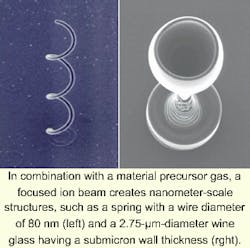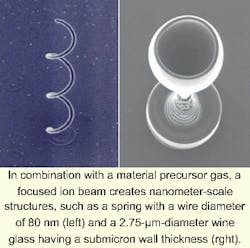Ion beam forms nanoscale objects
MEMS
Incorporating news from O plus E magazine, Tokyo
HYOGOCollaboration between Himeji Institute of Technology, NEC (Tokyo) and Seiko Instruments (Mihamaku) has resulted in a technology that allows nanometer-scale three-dimensional objects to be freely constructed using one of many different kinds of materials. This technology, which uses an ion beam, makes possible the manufacture of high-quality control elements for optical communications systems.
Techniques for performing optical sculpting using laser light are becoming more practical. Such laser setups, however, require systems of stages and mirrors that boost the focused-beam diameter above the micron level, far too coarse to make nanometer-scale features.
In the ion-beam technique, carbon is accumulated when gallium ions are accelerated through gaseous aromatic hydroxide, reducing the hydroxide. A focused-ion-beam apparatus, courtesy of Seiko Instruments, is used for the experiment. The beam can be focused down to 7-nm diameter at a 30-kV acceleration voltage, with a 1-nm positional beam-scan placement that is achieved by maintaining high accuracy of the electromagnetic field polarization.
A silicon substrate is placed inside a vacuum chamber operating at a pressure of 2 x 10-5 Pa. The gas that serves as the material precursor is bled in until a pressure of about 5 x 10-5 Pa is reached. When gallium ions are introduced into the arrangement, carbon accumulates on the substrate. As more gas is pumped in under the gallium ion beam, more carbon atoms stick together while the gas undergoes reduction. By changing the beam-scan speed, carbon can be grown not only in the beam irradiation direction, but also in the substrate direction. The minimum resolution during fabrication is about 80 nm.
A coil created using this method has an outer diameter of 600 nm and a line width of 80 nm (see figure). The material precursor gas is phenanthroline (C14H10), while the fabrication time is 40 s. The accumulated material is amorphous carbon containing a high proportion of diamond-like carbon. The coil has been tested for springlike qualities, confirming that its strength is close to that of metals. A drill with an outer diameter of 100 nm, a bellows-type pipe with a 2.75-µm outer diameter, and a wine glass with a 2.75-µm outer diameter have all been fabricated using carbon.
Changing the material gas can change the composition of the accumulated material. The material can be chosen freely, since organic metal hydrocarbons are commonly available on the market. In addition, by changing the gas during the process, it is possible to incorporate, for instance, both conductors and insulators in the same object.
This method, which can be used to make electromechanical components, shows promise as a way of producing micromirror-based optical switches for communications. Each component would be both light and very precise, so the response time for switches should become much faster. Photonic devices also could be built into such micromachines. The technique may have medical applications as well: given that a human red blood cell is approximately 8 µm in size, surgery on individual blood cells may become possible.
Courtesy O plus E magazine, Tokyo

